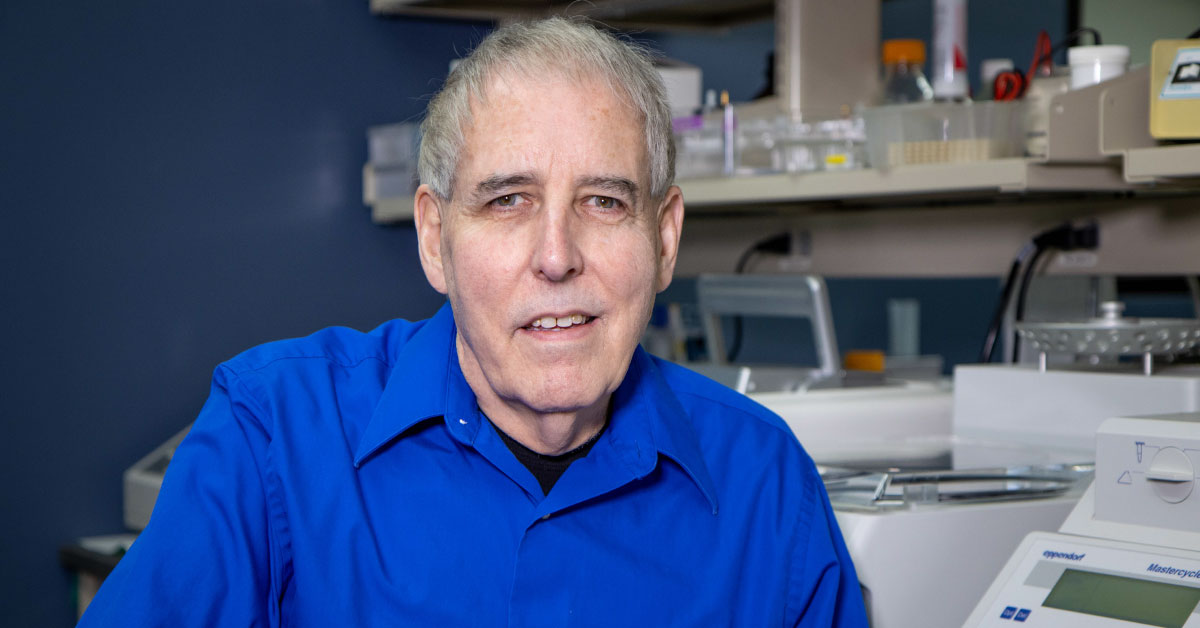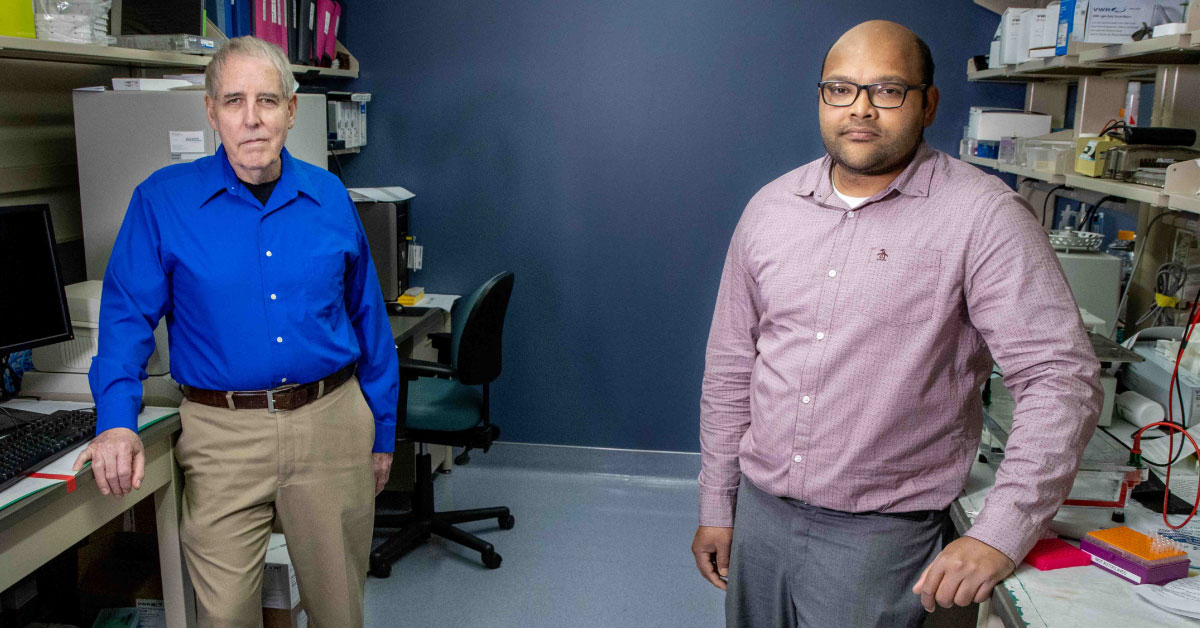Research More Clearly Defines Subgroups of High-Risk Patients
 Results from a study conducted by a research team led by C. Patrick Reynolds, M.D., Ph.D., director of the Texas Tech University Health Sciences Center (TTUHSC) School of Medicine Cancer Center, may prove to be a landmark in pediatric oncology.
Results from a study conducted by a research team led by C. Patrick Reynolds, M.D., Ph.D., director of the Texas Tech University Health Sciences Center (TTUHSC) School of Medicine Cancer Center, may prove to be a landmark in pediatric oncology.
The research, “Telomere maintenance mechanisms define clinical outcome in high-risk neuroblastoma,” was published online April 14 by Cancer Research and may lead to revisions of the risk stratification process for neuroblastoma, one of the deadliest childhood cancers.
The team included Balakrishna Koneru, Ahsan Farooqi, Thinh H. Nguyen, Shawn J. Macha, Eduardo Urias, Ashly Hindle, Heather Davidson, Kristyn McCoy, Jonas Nance, Vanda Yazdani and Shengping Yang from the TTUHSC Cancer Center; Gonzalo Lopez, Karina L. Conkrite, Apexa Modi, Jo Lynne Rokita, John M. Maris and Sharon J. Diskin from Children's Hospital of Philadelphia and the Perelman School of Medicine at the University of Pennsylvania; Meredith S. Irwin from The Hospital for Sick Children (SickKids) in Toronto; and David A. Wheeler from the Baylor College of Medicine Human Genome Sequencing Center.
The neuroblastoma risk stratification scale currently applied across the country classifies patients into three categories: low, intermediate and high risk. Reynolds said low-risk patients have tumors that likely won’t progress. Some require no treatment therapy, while others may require surgery or minimal chemotherapy. Intermediate-risk patients may require some chemotherapy, but their tumors are generally controlled with therapy. High-risk patients require aggressive treatment that can include high doses of chemotherapy, radiation, stem cell transplants and finally maintenance therapy with drug and immunotherapy.
Each category is primarily based upon the stage and spread of the disease, the patient’s age and the amplification of an oncogene known as MYCN, a member of the MYC gene family that produces proteins linked to cell growth, maturation and death. Previous research has shown that neuroblastoma patients with amplified MYCN, the presence of more than 10 copies of MYCN, have poor outcomes no matter their age or the stage of the disease.
Reynolds said the treatment for high-risk patients has evolved from multi-drug chemotherapy to intensive myeloablative therapy. Myeloablative therapy is supported by blood stem cell transplant because the therapy is so intense that the bone marrow is killed and has to be replaced by infusing new stem cells. This process, which often includes radiation to sites of known prior tumor mass given after the completion of the stem cell transplants, improved survival rates. However, it is hard on patients because it employs very toxic therapy. A recent study showed that survival of patients given two sequential treatments with myeloablative therapy and stem cell transplant is better than only one for high-risk patients.
 Myeloablative therapy is then followed by maintenance therapy that uses13-cis-retinoic
acid and the antibody dinutuximab plus a cytokine. Cytokines are molecules that stimulate
the immune system to use the antibody to kill cancer cells.
Myeloablative therapy is then followed by maintenance therapy that uses13-cis-retinoic
acid and the antibody dinutuximab plus a cytokine. Cytokines are molecules that stimulate
the immune system to use the antibody to kill cancer cells.
“Even though the survival has improved for high-risk neuroblastoma with use of intensive, multi-modality therapy, we still have a number of them, almost half of them, that are eventually going to die from the progressive disease,” Reynolds said. “So the real question in this paper was could we understand the biology better by looking at telomere maintenance mechanisms (TMMs) as markers to identify patients with ultra high-risk disease.”
The DNA contained within human cells is arranged in linear chromosomes; telomeres are caps located on the ends of each chromosome. When human cells divide, a small part of DNA is lost from the telomeres with each division, but because they do not contain genetic information, continual loss of a portion of the cap, or telomere is feasible. This helps to protect important genomic information so it can pass intact to the new cell.
Cells passed from one generation to the next, like stem cells and germ cells, need to divide many times as they grow. For the division and growth to continue, cells must be able to restore the caps, or telomeres that are damaged during cell division. An enzyme, known also as a telomerase, can carry out telomere restoration and uniquely remake the caps on the ends of DNA chromosomes.
Most cells in our body have the telomerase turned off. Many cancer cells are able to switch on telomerase, which they need to enable the continual cell division that is the hallmark of cancer. However, some cancer cells, including some neuroblastomas, are able to grow continuously without turning on telomerase. Instead, they grow by using an alternate lengthening of telomeres (ALT) mechanism that can make telomeres without telomerase.
Roger Reddell, a scientist in Australia who collaborates with TTUHSC researchers, developed a DNA marker known as a C-circle assay that could help identify tumors that use ALT to grow. An early question in the study was how many neuroblastoma patients had ALT tumors, using the specific and sensitive C-circle assay. Evidence had suggested that ALT tumors carried a mutation in a gene known as ATRX, which led many labs across the world to investigate methods for targeting ATRX mutations. Thus, a second question was whether or not all ALT tumors had ATRX mutations.
Working together with a group of investigators led by John Maris, M.D., at Children’s Hospital of Philadelphia that were carrying out a National Cancer Institute (NCI) TARGET initiative to generate genomic information on childhood cancers, the Reynolds team obtained a large quantity of tumor samples previously sequenced that had the ATRX mutation and a second large batch sequenced as ATRX-wild, or lacking the mutation. They wanted to investigate whether or not they could establish subgroups of ALT patients by examining two potential markers: expression of the TERT gene, which is the gene that codes for telomerase enzyme, and the presence or absence of the C-circle marker for ALT.
“We looked for the presence of the C-circle marker and sure enough, all the ATRX mutants were positive,” Reynolds said. “But there were also C-circle positive tumors that had no ATRX mutation, so that got us to work with the TARGET group to expand the number of tumors we studied.”
Koneru, who carried out the laboratory studies as part of his Ph.D. research at TTUHSC and authored the published results, began analyzing and comparing the samples and quickly discovered that 4% of ALT tumors lacked the ATRX mutation. However, by looking at the combination of the expression of a key telomerase gene (TERT) combined with the ALT marker, he was able to divide high-risk neuroblastoma patients into three subgroups.
The first subgroup had high TERT expression, some caused by rearrangement of that gene, some by amplification of the MYCN gene, and some via unknown mechanisms. Reynolds said this group is well known and represents approximately 60% of high-risk neuroblastoma patients. The second subgroup, representing about 20% of high-risk patients, was the ALT patients. This group had not previously been as clearly defined, but was known to have a poor overall survival rate. The third group, which Reynolds said had not previously been described by anyone, was a group that had low telomerase and no C-circles (i.e., no evidence of TMMs).
“By every marker we have, clinical and biological, we say they have really high-risk disease; they need a tandem transplant,” Reynolds said. “We found that there are a subset of about 20% of these patients that have no evidence of telomere maintenance, and lo and behold, those patients do extremely well; their overall survival was very high.”
 Reynolds said the percentage of patients in the third group develops resistance to
chemotherapy and progress the same as the other patients, yet they experience high
overall survival rates. That suggests when these patients are treated long enough,
their telomeres are eroding, making their tumors susceptible to induction or re-induction
therapy, which is chemotherapy, radiotherapy or immunotherapy given to salvage patients
who have relapsed neuroblastoma.
Reynolds said the percentage of patients in the third group develops resistance to
chemotherapy and progress the same as the other patients, yet they experience high
overall survival rates. That suggests when these patients are treated long enough,
their telomeres are eroding, making their tumors susceptible to induction or re-induction
therapy, which is chemotherapy, radiotherapy or immunotherapy given to salvage patients
who have relapsed neuroblastoma.
“We've known for a number of years that some patients classified as having high-risk neuroblastoma respond to re-induction therapy when they relapsed, and some survive,” Reynolds said. “We never really understood why, and now we have robust biomarkers in TERT expression and C-circles that when combined allow identification of this group of TMM-negative patients who have surprisingly good outcomes. To summarize, what this paper shows is that there's a group of patients that we can identify with novel markers that do extremely well and two other groups that don't do as well, and we can pick them out.”
Reynolds said the two groups that don't do well each has unique potential therapeutic marker targets that his team and others are working on, so this study may in the future enable precision medicine for those two truly high-risk groups of patients.
“In the future, it may also lead to a reduction in the intensity and toxicity of therapy for the TMM negative group that has such a high survival,” he added.
Reynolds said the results already have led the Children’s Oncology Group (COG) to work on developing a new risk stratification scheme that incorporates the two new sets of markers that he and Koneru have published. The COG is sending tumor samples from the latest national high-risk study of randomized tandem and single transplants to TTUHSC, and Koneru is using the same techniques to analyze whether the new subgroup characteristics apply to these tumors.
If the results are confirmed, Reynolds believes a new risk stratification scale will be implemented nationally and will likely become the basis in the future for a new international risk stratification scale.
“I think this is going to change not only the way we treat neuroblastoma patients across North America, but literally across the world.”
